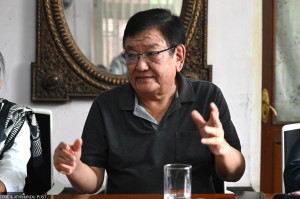Miscellaneous
Year Ender 2016: Redefining mall culture
TeamQuest, which revolutionised the movie-going experience by introducing multiplex cinemas in Nepal, injects new life into a concrete carcass and turns it into an iconic mall
Rupak D. Sharma
Ironically, the most iconic mall in Nepal came into existence out of serendipity rather than careful planning.
Around five years ago, TeamQuest—which revolutionised the movie-going experience in the country by introducing multiplex theatre brand, QFX Cinemas, in 2002—was scouting for a location in Lalitpur to build its new movie theatre.
“We knew Lalitpur was an affluent part of Kathmandu Valley and we wanted to gain a foothold,” says Nakim Uddin, one of the three TeamQuest directors.
Their search finally ended at Pulchowk, where Lalitpur Bishal Bazar Multiplex, a shopping centre, had just come into operation. Core TeamQuest members, which also include Bhaskar Dhungana and Rajesh Kumar Siddhi, then held several rounds of meetings with the multiplex owners.
“The talks ended in us agreeing to add a storey to the building to open the movie theatre,” says 52-year-old Nakim.
Lalitpur Bishal Bazar Multiplex, a four-storey building spread over 12 ropanis of land, was located in one of the prime areas of Lalitpur. And by the time owners of the shopping centre had met TeamQuest they had already spent Rs150 million to Rs200 million to build the complex.
Yet it was fast turning into a concrete carcass, as store vacancy rate was high and even those who had set up shops were not able to draw in the crowds.
The only tenants that were seeing a regular flow of customers at that time were Laxmi Bank and Lalitpur Party Palace. Otherwise, the place—which had quite a number of mobile phone stores—was virtually dead.
“Probably because of this reason, the multiplex owners, during one of the meetings, expressed interest to sell the property,” says the soft-spoken Nakim.
Nakim saw this as an opportunity to diversify the business.
Those with business acumen always tell you not to put all the eggs in one basket, because they believe business diversification automatically diversifies the risk. That’s the rule of thumb.
Having said that, TeamQuest’s strength, at that time, was movies—whether in terms of operating world-class movie theatres or distributing Hollywood and Bollywood movies in Nepal—not malls. Besides, buying a mall and renovating it meant spending, or rather investing, millions of rupees.
But Nakim was fascinated by the idea of operating a mall. So, he encouraged his business partners, Dhungana and Siddhi, to take the plunge. They agreed.
“Well, in the process of opening a movie theatre we ended up opening a mall,” says Nakim, a movie buff.
The next move that TeamQuest made was to reach out to Rajesh Verma, an Indian architect who previously had helped QFX set up movie halls in Nepal. The design proposed by Verma, who has experience of developing mall spaces of 2 to 3 million sqm, required demolition of around 12,000 sqft of space and the construction of an atrium.
As everything was being finalised, problems started brewing. “There were tenants who had leased the space for 25 years from the previous owner and they had to be evicted,” says Nakim. “It took almost a year to settle those cases.”
Then the country was hit by devastating earthquakes in April and May, 2015, which was followed by an Indian trade embargo, which prolonged from September 2015 to February this year. All these further affected construction works and delayed the mall’s opening.
Then in April this year, a new look mall finally opened its doors to the public.
In its new avatar, Lalitpur Bishal Bazar Multiplex, or better known as Labim Mall these days, has already emerged as one of the most recognisable landmarks in Kathmandu Valley, drawing hordes of fashion enthusiasts, mid-aged professionals and high-school seniors, who consider hanging out with friends at malls a transition to adulthood.
The mall is a mishmash of 19th century architecture—as parts of the walls made of reddish-orange bricks and white mortar give it a rustic look—and modernist design—reflected in shiny tiles, a glass roof and transparent elevator that rises through the middle of the building.
Some of the people have been so impressed by the chic architecture and interiors of Labim they have even called on the government, through the social media, to rope in its designers while building projects like airports.
Spread over 200,000 sqft, the mall is also eco-friendly, as the glass roof allows natural light to permeate, illuminating the interiors. And the mall’s theme, ‘Come Walk the Street’, sounds apt as there is little chance shoppers or strollers will miss the iconic store or get lost.
“Labim Mall has tried to encapsulate the high-street fashion scene of Durbar Marg and food culture of Jhamel [Jhamsikhel],” says Nakim.
This can be seen from a slew of internationally renowned brands, such as Clarks, North Face, Timberland, Converse, US Polo Assn, United Colours of Benetton and Lego, that have set up shops at the mall. The mall also has outlets of Roadhouse Cafe for those who prefer wood-fired pizza, Mango Chilli for Thai food lovers, Himalayan Java for coffee enthusiasts, and one of the favourites of Nepalis, Dalle, which serves momos and other fast food items. The mall also has a roof-top bar, stores that sell gadgets, beauty products and other fashion accessories, fast food restaurants in the open space outside, and of course movie theatres.
Like malls all over the world, Labim has also tried to provide complete lifestyle experience under one roof so that people could shop, socialise and entertain.
If things go according to plan, the mall will also have Labim Auto Hub in the next one-and-a-half months, which will include 14 outlets of cars and motorbikes, according to Nakim. Yet few of the things that will probably not be available at the mall in the coming days are grocery items and furniture.
Minus some flaws, TeamQuest, which revolutionised the movie-going experience by introducing multiplex cinema in Nepal, has now redefined the mall culture. And this has definitely exerted pressure on malls like Civil, City Centre and KL Tower, which used to be the talk of the town prior to the advent of Labim.
“We have definitely raised the bar,” says Nakim. “And it feels good because transformations happen like this—although running a mall is not an easy job, as you have to deal with plenty of tenants who have their own views.”




 21.12°C Kathmandu
21.12°C Kathmandu










